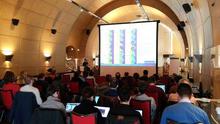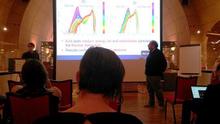news
Submitted on 2017-05-05
Who will win the 2017 International Space Weather Medals? Nominate your candidates.
Submitted on 2017-04-26
EUI, SPADE and SUVI are just a few of important space weather projects that are currently being tested on ground or in orbit.
Submitted on 2017-04-20
On 18 April, active region NOAA 2651 produced an impressive solar eruption.
Submitted on 2017-04-11
On 28 March, USET solar telescopes captured stunning images of a plane transiting the Sun.
Submitted on 2017-04-05
On 1 April, the Sun produced its first M-class flare since 29 November 2016. It was the first of a series of 7 M-class flares produced by active region NOAA 2644.
Submitted on 2017-03-29
Late on 26 March, the GOES-15 satellite recorded its first C-class flare since 24 February.
Submitted on 2017-03-27
The officially recordholder of catching non-existing flares works at the STCE. He works at the source of the solar data and 'saw' them first.
Submitted on 2017-03-22
On 21 March, a tiny spot near the Sun's east limb marked the end of a spotless stretch that started on 6 March.
Submitted on 2017-03-13
The annual CHARM meeting took place at the ROB on 10 March.
Submitted on 2017-03-10
The ESWW14 committee released a list of potential session topics. Also, the ESWW14 will be co-located with the 9th European CubeSat Symposium.
Pages
Zircon - This is a contributing Drupal Theme
Design by
WeebPal.







































